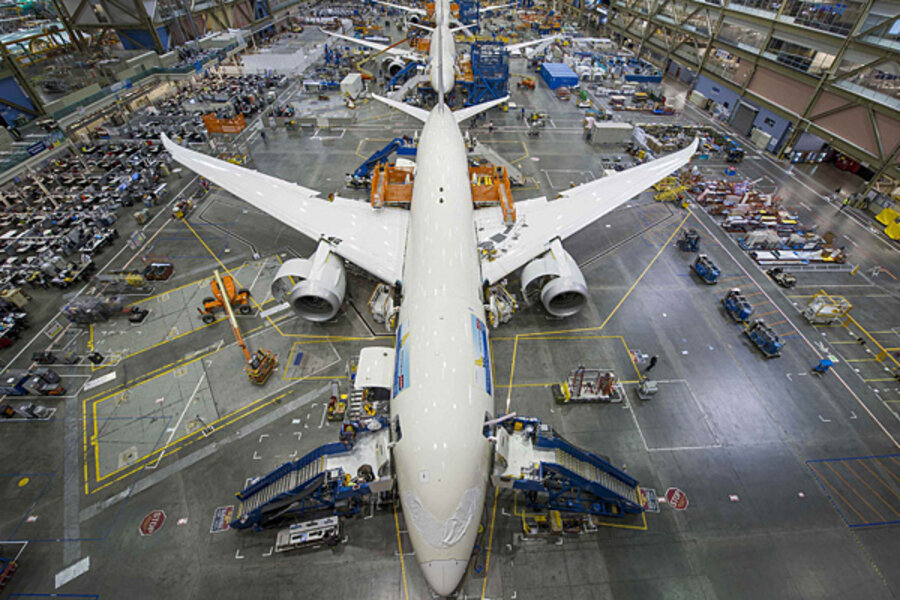Boeing 787 Dreamliner back in US skies. Battery questions linger.
Loading...
The Boeing 787 Dreamliner returned to American skies Thursday for its first US passenger flight since overheating batteries grounded the fleet in January.
It's an encouraging sign, not just for the beleaguered airplane manufacturer, but for lithium-ion technology as well. The powerful, lightweight batteries had overheating and other problems when they were first used in laptop computers and electric cars. But manufacturers ironed out many of those issues, and there's hope for a similar learning curve in aviation.
"The chemistry of these batteries is changing. They can be made better," Richard Aboulafia, vice president of analysis at Teal Group Corp., an aerospace analysis firm, said in a telephone interview. "They still offer a powerful and economic solution. It’s just a question of getting the chemistry right and getting the system right."
In the short term, Boeing has implemented a series of fixes to the Dreamliners' batteries approved by the Federal Aviation Administration. Those involve more spacing between battery cells to reduce the risk of overheating, and storing them in a stronger, sealed encasement to minimize damage should overheating occur again. The casing now also includes a vent to the exterior, allowing smoke to escape in the case of a fire.
Passenger flights resumed in late April when Ethiopian Airlines carried a Dreamliner full of passengers – including Boeing vice president Randy Tinseth – from Addis Ababa, Ethiopia, to Nairobi, Kenya. Monday's United Continental flight from Houston to Chicago marks the Dreamliner's return to the US. United chief executive Jeff Smisek and Boeing chief executive James McNerney were among the passengers of Monday's flight, The Chicago Tribune reports.
The battery retrofit makes the Dreamliner safer, Boeing representatives and FAA officials stress. More than 100,000 hours were spent developing test plans for the fix, building test rigs, conducting tests, and analyzing the results to ensure the proposed solutions met all requirements, according to Boeing.
"This is a comprehensive and permanent solution with multiple layers of protection," Ray Conner, president and chief executive of Boeing Commercial Airplanes, said in a statement after the fix was developed in April. "The ultimate layer of protection is the new enclosure, which will ensure that even if a battery fails, there is no impact to the airplane and no possibility of fire. We have the right solution in hand, and we are ready to go."
But some important questions remain. Namely, what caused the 'thermal runaways' that caused a fire in one Dreamliner and forced an emergency landing in another?
"We know what happened, but we don’t know the 'why,' " Addison Schonland, a partner at aerospace consulting firm AirInsight, said in a telephone interview. "I’m not sure we can be 100 percent certain that the problem is solved. We know that were an event to happen again, the impact would probably be a lot less scary than it has been up to now."
The public relations headache is familiar to laptop manufacturers and electric carmakers whose early implementations of the technology quite literally went up in flames.
Boeing was the latest company to bet on the lithium-ion battery. The technology's high energy density is ideal for an industry constantly searching to shed fuel-saving pounds from its product.
But Boeing suffered the lithium-ion curse as well. Hiccups and delays culminated in the fleet's grounding after two high-profile battery incidents.
Some attribute that to Boeing's reliance on an elaborate supply chain. About 70 percent of the planes components were outsourced in an effort to save costs, according to a 2009 study by researchers at University of California, Los Angeles. By comparison, 35 to 50 percent of Boeing's 737 program were left to outside firms.
With a fix in place but the root cause still unknown, Mr. Aboulafia said the question is not so much one of safety as it is of economics and convenience.
"Unless they deal with this, there’s the risk that this aircraft will have more than its share of groundings and replacement work," he said. "You don't want a red light to come on when you're about to take off for a foreign city with 250 passengers on board."






